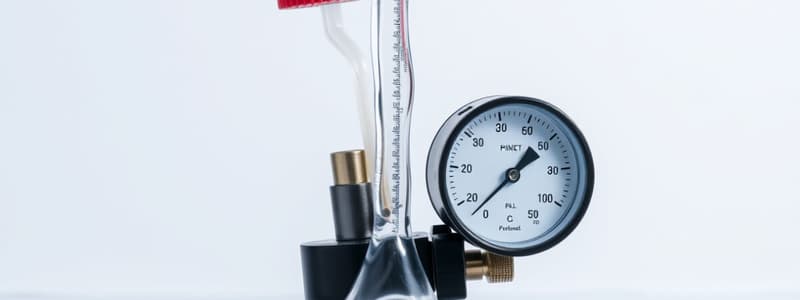Podcast
Questions and Answers
What is the primary use of an inclined tube manometer?
What is the primary use of an inclined tube manometer?
- To measure fluid flow rates
- To measure temperature variations in liquids
- To measure large-scale pressure changes
- To measure small changes in pressure (correct)
In terms of pressure transducers, what characterizes a gauge transducer?
In terms of pressure transducers, what characterizes a gauge transducer?
- It is only used for low-pressure measurements
- It measures the absolute pressure only
- It is open to atmospheric pressure (correct)
- It measures pressure at absolute zero
Which type of pressure transducer measures the difference between two applied pressures?
Which type of pressure transducer measures the difference between two applied pressures?
- Vacuum transducer
- Absolute transducer
- Gauge transducer
- Differential transducer (correct)
What is linked to the resistance of shear forces in a fluid?
What is linked to the resistance of shear forces in a fluid?
What error might a pressure transducer experience due to environmental temperature changes?
What error might a pressure transducer experience due to environmental temperature changes?
What is the Mach number condition for considering flow as incompressible?
What is the Mach number condition for considering flow as incompressible?
In thermal anemometry, what is the role of thermal conductance in measuring fluid velocity?
In thermal anemometry, what is the role of thermal conductance in measuring fluid velocity?
For supersonic flow (M > 1), what must be used to calculate local velocity?
For supersonic flow (M > 1), what must be used to calculate local velocity?
Which type of sensor in thermal anemometry operates with a thin film of platinum or gold?
Which type of sensor in thermal anemometry operates with a thin film of platinum or gold?
What is the relationship between heat transfer (Q) and cooling velocity in thermal anemometry?
What is the relationship between heat transfer (Q) and cooling velocity in thermal anemometry?
Flashcards are hidden until you start studying
Study Notes
Inclined Tube Manometer
- Measures small pressure changes using a U-tube design with one leg inclined at an angle (typically 10 to 30 degrees).
- Useful for low-density fluid pressure measurements.
Shear Forces and Viscosity
- Shear forces act parallel to a surface, impacting fluid behavior.
- Resistance to shear in fluids is linked to viscosity; high viscosity indicates greater resistance.
Buoyancy
- An object's buoyancy in a fluid equals the weight of the fluid displaced, explaining why some lighter objects float while denser ones may sink yet are easier to move underwater.
Pressure Transducers
- Categories include:
- Absolute: Measures against absolute zero pressure.
- Gauge: Measures pressure relative to atmospheric pressure.
- Vacuum: A variation of absolute, used for low-pressure measurements.
- Differential: Measures the difference between two pressures.
- Common errors include resolution, zero shift error, linearity, sensitivity, hysteresis, noise, and temperature-induced drift.
Mach Number
- Defined as M = U / a, where U is local velocity and a is the speed of sound.
- Flow is considered incompressible when M ≤ 0.3; significant errors arise when M > 0.3.
Thermal Anemometry
- Measures fluid velocity based on heat transfer principles.
- Sensor typically uses a metallic RTD element and operates on current-based heating.
- Two operating modes: Constant Current (CC) and Constant Resistance (CR).
- High sensitivity at low velocities with frequency limits determined by Strouhal frequency.
Doppler Anemometry
- Relies on the Doppler Effect where wave frequency shifts due to the motion between source and observer.
- Measures local fluid velocity using particles causing Doppler shifts in emitted laser light.
- Dual-Beam Mode increases measurement accuracy by separating Doppler frequencies.
Mass Flow Rate
- Calculated as mass flux times area (A = π.r²).
- Units measured in kg/s or lbm/s.
- Accurate mass flow measurement requires sensitivity to fluid density and velocity.
Volume Flow Rate
- Depends on average velocity over the flow's cross-section.
- Units measured in m³/s or ft³/s.
- Distinguished from mass flow rate, which requires density consideration.
Flow Characteristics
- Flow can be classified as laminar, turbulent, or transitional based on the Reynolds number (Re).
- Laminar: Re < 2000
- Transitional: 2000 ≤ Re ≤ 4000
- Turbulent: Re > 4000
- Hydraulic diameter used for non-circular conduits.
Flow Measurement Installation
- Sufficient straight lengths before and after flow meters are crucial for accurate measurements to minimize disturbances.
- Downstream pressure recovery is necessary for stable flow post-meter passage.
- Elbows and bends should be carefully considered during placement to avoid inaccuracies in flow measurements.
Studying That Suits You
Use AI to generate personalized quizzes and flashcards to suit your learning preferences.




